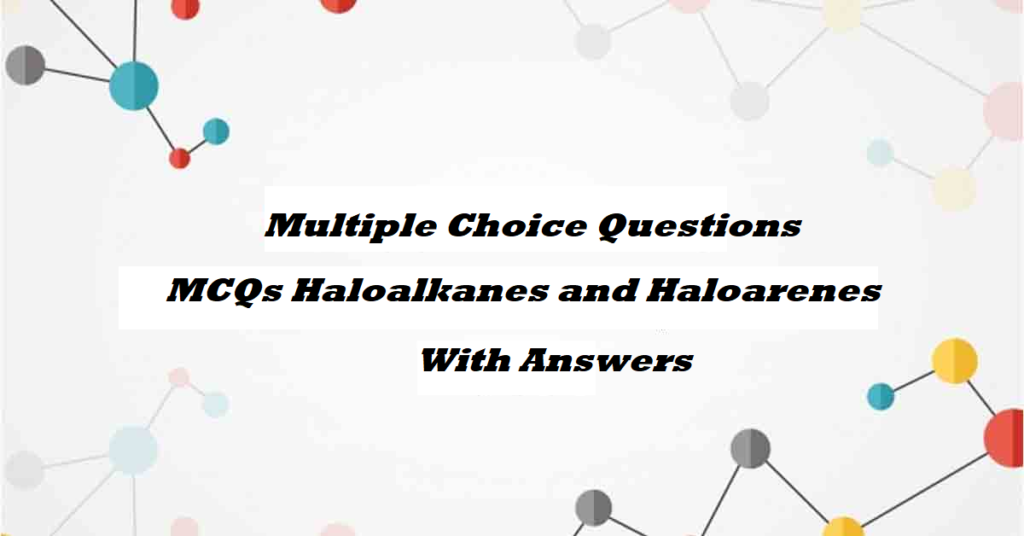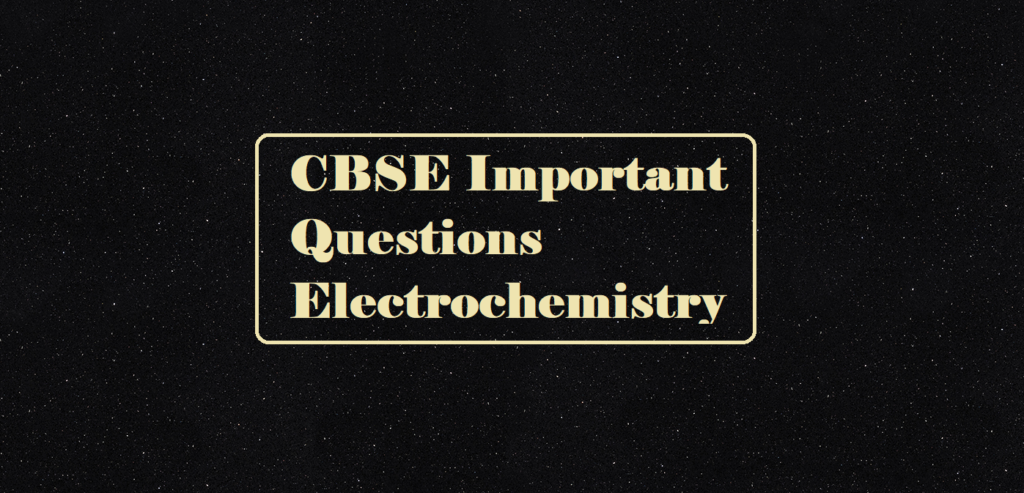MCQs Haloalkanes and Haloarenes
MCQs Haloalkanes and Haloarenes is all about multiple choice questions of Haloalkanes and haloarenes
Q 1. The order of reactivity of following alcohols with halogen acids is ___________.
(A) CH3CH2 —CH2—OH

(i) (A) > (B) > (C)
(ii) (C) > (B) > (A)
(iii) (B) > (A) > (C)
(iv) (A) > (C) > (B)
Ans. (ii)
Explanation: Greater the stability of carbocation, the greater will be its ease of formation
from an alkyl halide and faster will be the rate of reaction. In the case of alkyl halides, 30 alkyl
halides undergo SNI reaction very fast because of the high stability of 30 carbocations.
Q 2. Which of the following alcohols will yield the corresponding alkyl chloride on
reaction with concentrated HCl at room temperature?
(i) CH3CH2—CH2 —OH

Ans. (iv)
Explanation: The reactions of primary and secondary alcohols with HCl require the
presence of a catalyst, ZnCl2. With tertiary alcohols, the reaction is conducted by simply
shaking with concentrated HCl at room temperature. The order of reactivity of alcohols
with a given haloacid is 3o>2o>1o
Q 3. Identify the compound Y in the following reaction.
![]()

Ans. (i)
Explanation: The Cl-, Br-and CN- nucleophiles can easily be introduced in the benzene
ring of diazonium salts in the presence of Cu(I) ion.
Q 4. Toluene reacts with a halogen in the presence of iron (III) chloride giving ortho and
para halo compounds. The reaction is
(i) Electrophilic elimination reaction
(ii) Electrophilic substitution reaction
(iii) Free radical addition reaction
(iv) Nucleophilic substitution reaction
Ans. (ii)
Explanation: Aryl Chlorides and bromides can be easily prepared by electrophilic
substitution of arenes with chlorine and bromine respectively in the presence of Lewis
acid catalysts like iron or iron (III) chloride.
Q 5. Which reagent will you use for the following reaction?
CH3CH2CH2CH3 → CH3CH2CH2CH2Cl + CH3CH2CHClCH3
(i) Cl2/UV light
(ii) NaCl + H2SO4
(iii) Cl2 gas in dark
(iv) Cl2 gas in the presence of iron in dark
Ans. (i)
Explanation: Free radical chlorination or bromination of alkanes gives a complex
mixture of isomeric mono- and polyhaloalkanes, which is difficult to separate as pure
compounds. Consequently, the yield of anyone free radical chlorination or bromination
of alkanes gives a complex
Q6. Which of the following structures is enantiomeric with the molecule (A) given
below :

Ans. (i)
Explanation: The stereoisomers related to each other as non-super impossible mirror
images are called enantiomers. Enantiomers possess identical physical properties.
Q 7. Which of the following is an example of vic-dihalide?
(i) Dichloromethane
(ii) 1,2-dichloroethane
(iii) Ethylidene chloride
(iv) Allyl chloride
Ans. (ii)
Explanation: In 1,2 dichloroethane, the two chlorine atoms are attached to two adjacent
carbon atoms.
Q 8. The position of –Br in the compound in CH3CH=CHC(Br)(CH3)2 can be classified as
____________.
(i) Allyl
(ii) Aryl
(iii) Vinyl
(iv) Secondary
Ans. (i)
Explanation: These are the compounds in which the halogen atoms are bonded to an sp3-
hybridised carbon atom next to carbon-carbon double bond (C=C) i.e., to an allylic
carbon.
Q 9. Chlorobenzene is formed by the reaction of chlorine with benzene in the presence of
AlCl3. Which of the following species attacks the benzene ring in this reaction?
(i) Cl–
(ii) Cl+
(iii) AlCl3
(iv) [AlCl4]-
Ans. (ii)
Q 10. Ethylidene chloride is a/an ______________.
(i) vic-dihalide
(ii) gem-dihalide
(iii) allylic halide
(iv) vinylic halide
Ans. (ii)
Explanation: In gem-dihalides, halogen atoms are present on the same carbon atom.
They are known as alkylidene halides CH3—CHCl2. Both halogen atoms are present on
same carbon atom so, it is gem-dihalide.
Q 11. What is ‘A’ in the following reaction?

Ans. (iii)
Explanation: In this reaction addition of HCl takes place on the doubly bonded carbon atom
in accordance with Markovnikov’s rule i.e., the addition of negative species will take place
on the carbon which has a lesser number of hydrogen.
Q 12. A primary alkyl halide would prefer to undergo _____________.
(i) SN1 reaction
(ii) SN2 reaction
(iii) α–Elimination
(iv) Racemisation
Ans. (ii)
Explanation: SN2type (bimolecular nucleophilic substitution). These reactions proceed
in one step and the rate of reaction depends on the concentration of alkyl halide as well as
nucleophile i.e. r=k[RX][Nu]. It is a second-order reaction. During SN2 reaction inversion in configuration occurs i.e., starting with dextrorotatory halide a laevo product is obtained, and vice-versa.
Q 13. Which of the following alkyl halides will undergo SN1 reaction most readily?
(i) (CH3)3C—F
(ii) (CH3)3C—Cl
(iii) (CH3)3C—Br
(iv) (CH3)3C—I
Ans. (iv)
Explanation: SN1 type (unimolecular nucleophilic substitution). These reactions proceed
in two steps. The rate of reaction is dependent on step 1 i.e., only on the concentration of
alkyl halide r =k [RX]. It is a first-order reaction.
R———X bond length in case of iodine is highest and that is why lowest bond dissociation enthalpy. Therefore, I- is known as the best leaving group.
Q 14. What should be the correct IUPAC name for diethylbromomethane?
(i) 1-Bromo-1,1-diethylmethane
(ii) 3-Bromopentane
(iii) 1-Bromo-1-ethylpropane
(iv) 1-Bromopentane
Ans. (i)
Q 15. Molecules whose mirror image is non-superimposable over them are known as
chiral. Which of the following molecules is chiral in nature?
(i) 2-Bromobutane
(ii) 1-Bromobutane
(iii) 2-Bromopropane
(iv) 2-Bromopropan-2-ol
Ans. (i)
Explanation: The objects which are non-superimposable on their mirror images are
called enantiomers. It occurs on that molecule which contains asymmetric carbon or
chiral i.e., a carbon atom attached with four different groups.
Q 16. Reaction of C6H5CH2Br with aqueous sodium hydroxide follows ____________.
(i) SN1 mechanism
(ii) SN2 mechanism
(iii) Any of the above two depending upon the temperature of the reaction
(iv) Saytzeff rule
Ans. (i)
Explanation: Greater the stability of carbocation, the greater will be its ease of formation from an alkyl halide and faster will be the rate of reaction. In the case of alkyl halides, 30 alkyl
halides undergo SNl reaction very fast because of the high stability of 30 carbocations.
For the same reasons, allylic and benzylic halides show high reactivity towards the SNl
reaction. The carbocation thus formed gets stabilized through resonance
Q 17. Which is the correct increasing order of boiling points of the following compounds?
1-Iodobutane, 1-Bromobutane, 1-Chlorobutane, Butane
(i) Butane < 1-Chlorobutane < 1-Bromobutane < 1-Iodobutane
(ii) 1-Iodobutane < 1-Bromobutane < 1-Chlorobutane < Butane
(iii) Butane < 1-Iodobutane < 1-Bromobutane < 1-Chlorobutane
(iv) Butane < 1-Chlorobutane < 1-Iodobutane < 1-Bromobutane
Ans. (i)
Explanation: For the same alkyl group, the boiling points of alkyl halides decrease in the
order: RI>RBr>RCl>RF. This is because, with the increase in size and mass of the halogen
atom, the magnitude of van der Waal forces increases.
Q 18. Which is the correct increasing order of boiling points of the following compounds?
1-Bromoethane, 1-Bromopropane, 1-Bromobutane, Bromobenzene
(i) Bromobenzene < 1-Bromobutane < 1-Bromopropane < 1-Bromoethane
(ii) Bromobenzene < 1-Bromoethane < 1-Bromopropane < 1-Bromobutane
(iii) 1-Bromopropane < 1-Bromobutane < 1-Bromoethane < Bromobenzene
(iv) 1-Bromoethane < 1-Bromopropane < 1-Bromobutane < Bromobenzene
Ans. (iv)
Explanation: The attractions get stronger as the molecules get bigger in size and have
more electrons.
In the following questions, two or more options may be correct. Consider the
following reaction and answer the questions no. 19-21.

Q 19. Which of the statements are correct about the above reaction?
(i) (a) and (e) both are nucleophiles.
(ii) In (c) carbon atom is sp3 hybridised.
(iii) In (c) carbon atom is sp2 hybridised.
(iv) (a) and (e) both are electrophiles.
Ans. (i) and (iii)
Explanation: It depicts a bimolecular nucleophilic displacement (SN2) reaction; the incoming nucleophile interacts with alkyl halide causing the carbon halide bond to break while forming a new carbon-OH bond. These two processes take place simultaneously in a single step and no intermediate is formed. As the reaction progresses and the bond between the nucleophile and the carbon atom starts forming, the bond between the carbon atom and the leaving group weakens. In part (c) it is the transition state where the carbon atom of the substrate molecule is sp2 hybridised.
Q20. Which of the following statements are correct about this reaction?
(i) The given reaction follows SN2 mechanism.
(ii) (b) and (d) have opposite configuration.
(iii) (b) and (d) have same configuration.
(iv) The given reaction follows SN1 mechanism.
Ans. (i) and (ii)
Explanation: As the SN2 reaction progresses and the bond between the nucleophile and
the carbon atom starts forming, the bond between the carbon atom and leaving group
weakens. As this happens, the configuration of carbon atom under attack inverts in much
the same way as an umbrella is turned inside out when caught in a strong wind, while the
leaving group is pushed away. This process is called an inversion of configuration.
Q21. Which of the following statements are correct about the reaction intermediate?
(i) Intermediate (c) is unstable because in this carbon is attached to 5 atoms.
(ii) Intermediate (c) is unstable because carbon atom is sp2 hybridised.
(iii) Intermediate (c) is stable because carbon atom is sp2 hybridised.
(iv) Intermediate (c) is less stable than the reactant (b).
Ans. (i) and (iv)
Explanation: In the transition state, the carbon atom is simultaneously bonded to the incoming nucleophile and the outgoing leaving group and such structure are unstable and cannot be isolated. This is because the carbon atom in the transition state is simultaneously bonded to five atoms and therefore is unstable.
Q 22. Alkyl halides are prepared from alcohols by treating with
(i) HCl + ZnCl2
(ii) Red P + Br2
(iii) H2SO4 + KI
(iv) All the above
Ans. (i) and (ii)
MCQs Haloalkanes and Haloarenes



